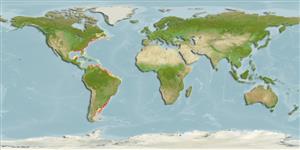Common names from other countries
Environment: milieu / climate zone / depth range / distribution range
Ekologi
; payau; kisaran kedalaman 0 - 43 m (Ref. 108755). Temperate
Eastern Pacific and Western Atlantic: North America, Canada to Brazil.
Length at first maturity / Size / Weight / umur
Maturity: Lm ?, range 0 - 0.55 cm Max length : 2.0 cm CW jantan/; (Ref. 79470); Umur maksimum dilaporkan: 2.00 Tahun (Ref. 109497)
Euryhaline. Prefers brackish waters, found in estuaries or quasi-freshwater lakes. Lives in muddy or sandy substrates, as well as on oyster reefs, vegetation, logs and manmade debris (Ref. 108786). Also on rubble (Ref. 97531). Omnivorous scavenger (Ref. 108786).
Life cycle: It undergoes four (4) zoeal stages and one (1) megalopa before turning into adult (Refs. 79470, 109437, 109442, 109461). Mating behavior: Precopulatory courtship ritual is common (through olfactory and tactile cues); usually indirect sperm transfer (Ref. 833). Spawning occurs from July to August in northern latitudes, April to September in mid latitudes, and April to November in southern latitudes (Ref. 109493). Females burrow in the sand to lay eggs prior to copulation, brooding takes 15-19 days (Ref. 109502).
rujukan utama
Acuan | Koordinator | mitra
Hill, M., R. Baker, G. Broad, P.J. Chandler, G.H. Coop, J. Ellis, D. Jones, C. Hoyland, I. Laing, M. Longshaw, N. Moore, D. Parrott, D. Pearman, C. Preston, R.M. Smith and R. Waters. 2005. (Ref. 1314)
Status IUCN Red List (Ref. 130435)
status CITES (Ref. 108899)
Not Evaluated
Not Evaluated
penggunaan manusia
| FishSource |
Alat, peralatan
Sumber internet
Estimates based on models
Preferred temperature
(Ref.
115969): 7.2 - 22.9, mean 14.2 (based on 234 cells).
Daya lenting
Tinggi, Waktu penggandaan populasi minimum kurang dari 15 bulan (K=1.28; tmax=2).
kategori harga
Unknown.
